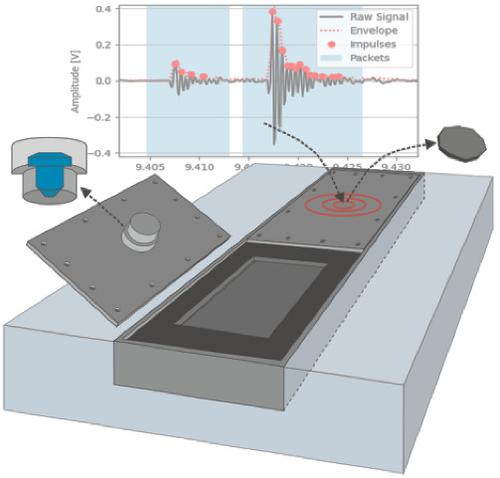当前位置:
X-MOL 学术
›
Earth Surf.Process. Land.
›
论文详情
Our official English website, www.x-mol.net, welcomes your
feedback! (Note: you will need to create a separate account there.)
Field and flume measurements with the impact plate: Effect of bedload grain-size distribution on signal response
Earth Surface Processes and Landforms ( IF 2.8 ) Pub Date : 2021-03-17 , DOI: 10.1002/esp.5117 Tobias Nicollier 1 , Dieter Rickenmann 1 , Arnd Hartlieb 2
Earth Surface Processes and Landforms ( IF 2.8 ) Pub Date : 2021-03-17 , DOI: 10.1002/esp.5117 Tobias Nicollier 1 , Dieter Rickenmann 1 , Arnd Hartlieb 2
Affiliation

|
The Swiss plate geophone is a bedload surrogate monitoring system that has been calibrated in several gravel-bed streams using direct sampling techniques. Past systematic flume experiments have highlighted the dependency of the signal response on the bed roughness and the flow velocity. To further develop the existing calibration approaches and better understand the role of site-specific factors, we conducted calibration measurements of the Swiss plate geophone system in two gravel-bed streams in the Swiss Alps with a crane-mounted net sampler. In parallel, we performed full-scale controlled flume experiments at an outdoor flume facility, where we reproduced the channel characteristics and the transport conditions observed at each field site. We evaluated changes in signal response using relations between the transported bedload mass and the number of detected impulses or packets (representing a single particle impact). Using experiments with single grain sizes, we confirmed that increasing flow velocity reduces the signal response. Additionally, we performed mixed-grain-size experiments and found that the grain-size distribution of the transported bedload can influence the signal response of the Swiss plate geophone system over more than one order of magnitude and lead to a biased estimation of the bedload flux. We show that the effect of the grain-size distribution on the signal response is visible at multiple field sites and discuss possible explanations for this phenomenon.
中文翻译:

使用冲击板进行场和水槽测量:床载粒度分布对信号响应的影响
瑞士板式地震检波器是一种床载替代监测系统,已使用直接采样技术在多个砾石床流中进行校准。过去的系统水槽实验强调了信号响应对床粗糙度和流速的依赖性。为了进一步发展现有的校准方法并更好地了解特定地点因素的作用,我们使用起重机安装的净采样器在瑞士阿尔卑斯山的两个砾石层流中对瑞士板地震检波器系统进行了校准测量。同时,我们在室外水槽设施中进行了全面受控水槽实验,在那里我们再现了在每个现场观察到的通道特征和运输条件。我们使用传输的床重质量与检测到的脉冲或数据包数量(代表单个粒子撞击)之间的关系来评估信号响应的变化。使用单一粒度的实验,我们证实增加流速会降低信号响应。此外,我们进行了混合粒度实验,发现传输的床载的粒度分布会影响瑞士板式地震检波器系统的信号响应超过一个数量级,并导致对床载通量的估计有偏差. 我们表明粒度分布对信号响应的影响在多个现场位置是可见的,并讨论了对这种现象的可能解释。使用单一粒度的实验,我们证实增加流速会降低信号响应。此外,我们进行了混合粒度实验,发现传输的床载的粒度分布会影响瑞士板式地震检波器系统的信号响应超过一个数量级,并导致对床载通量的估计有偏差. 我们表明粒度分布对信号响应的影响在多个现场位置是可见的,并讨论了对这种现象的可能解释。使用单一粒度的实验,我们证实增加流速会降低信号响应。此外,我们进行了混合粒度实验,发现传输的床载的粒度分布会影响瑞士板地震检波器系统的信号响应超过一个数量级,并导致对床载通量的估计有偏差. 我们表明粒度分布对信号响应的影响在多个现场位置可见,并讨论了对这种现象的可能解释。我们进行了混合粒度实验,发现传输的床载的粒度分布会影响瑞士板式地震检波器系统的信号响应超过一个数量级,并导致对床载通量的估计有偏差。我们表明粒度分布对信号响应的影响在多个现场位置是可见的,并讨论了对这种现象的可能解释。我们进行了混合粒度实验,发现传输的床载的粒度分布会影响瑞士板式地震检波器系统的信号响应超过一个数量级,并导致对床载通量的估计有偏差。我们表明粒度分布对信号响应的影响在多个现场位置是可见的,并讨论了对这种现象的可能解释。
更新日期:2021-03-17
中文翻译:

使用冲击板进行场和水槽测量:床载粒度分布对信号响应的影响
瑞士板式地震检波器是一种床载替代监测系统,已使用直接采样技术在多个砾石床流中进行校准。过去的系统水槽实验强调了信号响应对床粗糙度和流速的依赖性。为了进一步发展现有的校准方法并更好地了解特定地点因素的作用,我们使用起重机安装的净采样器在瑞士阿尔卑斯山的两个砾石层流中对瑞士板地震检波器系统进行了校准测量。同时,我们在室外水槽设施中进行了全面受控水槽实验,在那里我们再现了在每个现场观察到的通道特征和运输条件。我们使用传输的床重质量与检测到的脉冲或数据包数量(代表单个粒子撞击)之间的关系来评估信号响应的变化。使用单一粒度的实验,我们证实增加流速会降低信号响应。此外,我们进行了混合粒度实验,发现传输的床载的粒度分布会影响瑞士板式地震检波器系统的信号响应超过一个数量级,并导致对床载通量的估计有偏差. 我们表明粒度分布对信号响应的影响在多个现场位置是可见的,并讨论了对这种现象的可能解释。使用单一粒度的实验,我们证实增加流速会降低信号响应。此外,我们进行了混合粒度实验,发现传输的床载的粒度分布会影响瑞士板式地震检波器系统的信号响应超过一个数量级,并导致对床载通量的估计有偏差. 我们表明粒度分布对信号响应的影响在多个现场位置是可见的,并讨论了对这种现象的可能解释。使用单一粒度的实验,我们证实增加流速会降低信号响应。此外,我们进行了混合粒度实验,发现传输的床载的粒度分布会影响瑞士板地震检波器系统的信号响应超过一个数量级,并导致对床载通量的估计有偏差. 我们表明粒度分布对信号响应的影响在多个现场位置可见,并讨论了对这种现象的可能解释。我们进行了混合粒度实验,发现传输的床载的粒度分布会影响瑞士板式地震检波器系统的信号响应超过一个数量级,并导致对床载通量的估计有偏差。我们表明粒度分布对信号响应的影响在多个现场位置是可见的,并讨论了对这种现象的可能解释。我们进行了混合粒度实验,发现传输的床载的粒度分布会影响瑞士板式地震检波器系统的信号响应超过一个数量级,并导致对床载通量的估计有偏差。我们表明粒度分布对信号响应的影响在多个现场位置是可见的,并讨论了对这种现象的可能解释。











































 京公网安备 11010802027423号
京公网安备 11010802027423号